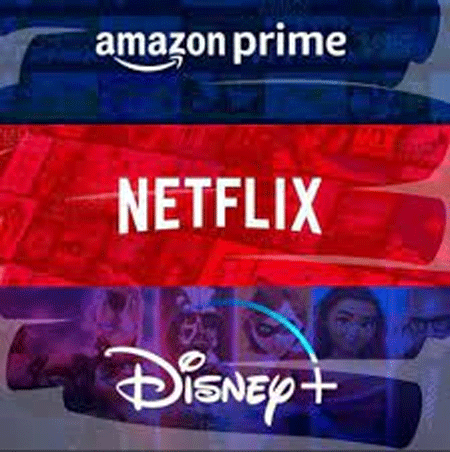COVID’s big winners
With infection levels dropping and the end of COVID seeming to be here, what companies were big winners because of how they reacted to the pandemic? Center founder Jeffrey Cole digs in.
By Jeffrey Cole
 Last time, we looked at the industries and companies that lost ground during the COVID Pandemic. This week we look at the winners, those who emerged stronger than ever before. We often resist finding new ways of doing things until its necessary. During COVID lockdown, it became absolutely necessary.
Last time, we looked at the industries and companies that lost ground during the COVID Pandemic. This week we look at the winners, those who emerged stronger than ever before. We often resist finding new ways of doing things until its necessary. During COVID lockdown, it became absolutely necessary.
Trends accelerated, some by years. A few well-placed and nimble companies benefited.
Amazon
How do you find the right superlatives?
In the first nine months of 2020, Amazon saw its earnings increase 70%. No big deal for a startup experiencing explosive growth, but at the beginning of 2020 Amazon was already a trillion-dollar behemoth. The stock price — at a record high of $1,785 on March 13, 2020 — almost doubled to $3,401 in a little over five months!
You can’t make these numbers up!
Amazon was ready for the pandemic, not that they expected or wanted it. It already had over 150 million customers so trained to go to its site to buy everything from toothpaste to televisions that they paid $119 a year for fast and “free” shipping. It felt like a lifeline before the virus changed our lives; during COVID it literally became a lifeline. As most stores closed (except for supermarkets) Amazon remained open. We bought things online that we had never bought there before. It filled the time and was fun to track the packages coming to our home.
After a few speed bumps in the beginning with slightly longer delivery times and supply issues (the whole country wanted masks, sanitizers, and thermometers at the same time), Amazon’s unparalleled logistics network swung into action and performed nearly flawlessly. Millions who were not Prime members joined, and those who before COVID had considered surrendering their membership became more loyal than ever. A Prime membership has become a permanent part of household budgets. This year, Amazon raised the cost of Prime by $20 to $139. All those who quit will fit into a single phone booth, and they are just as difficult to find as a phone booth!
Can Amazon get any bigger? It operates in three industries: retail, cloud storage and video streaming in 13 countries. As it moves into the biggest industries in the world (health care, financial services, and many more) and expands to 50 or more countries, we may come to think of today’s Amazon as a small, start-up.
Disney
Rarely has a company seen almost its entire business grind to a complete halt in a matter of days. In 2019, Disney dominated the box office producing eight of nine billion-dollar films and commanding nearly 40% of all theatrical sales.
Within a week of March 15, 2020, almost every movie theater closed. Disney’s theme parks shut their doors, and their cruise ships went to dry dock. Its stock price, at $141 on February 7, 2020, fell off a cliff to $85 in a month. Stability at Disney was also thrown for a loop when longtime CEO Bob Iger announced he was stepping down effective February 2020.
No one had realized how dependent Disney’s business was on people leaving their homes to go to the movies, theme parks, retail stores, and cruise ships. There was no reason in our lifetimes they needed to protect against a long-term lockdown.
The only good news was that four months before COVID arrived the company had launched its streaming service, Disney+.
Although it didn’t have enough programming for a pandemic when everyone was at home watching television, the channel quickly repurposed content intended for movie theaters. Disney+ became such a success that Iger’s successor, Bob Chapek, re-organized the entire company around it.
Disney also, more than any other studio, experimented when theaters finally opened by releasing some films to Disney+ and theaters at the same time (Day and Date) and others only to theaters or directly to their streamer. They used COVID as an unwanted but important learning exercise.
A year after COVID began, Disney’s stock was at $200 a share (although it has hit a rough patch recently).
Netflix
This is the streamer that was ready for everyone to be stuck at home. Their policy of releasing massive amounts of new programming every Friday from their $18 billion production budget paid off. It didn’t matter how good that programming was: it was new, and no one had seen it. It was good enough that three of their original shows became popular sensations during COVID: Tiger King, The Queen’s Gambit and Squid Game.
Netflix emerged from COVID as the most successful entertainment company in history. The first dollar anyone spends on entertainment is spent on Netflix. Although not literally a lifeline, Netflix felt like one. Like Amazon Prime, no one dared give up their subscription during the pandemic.
Labor
Since I was a little boy, power has shifted from labor to management. Labor unions, particularly in private industry, have weakened and lost large numbers of members. Many factories have opened in right-to-work states, and the minimum wage has grown far more slowly than the cost of living. Defined-benefits pensions have all but disappeared. Labor economists, looking at long term trends in the work force, believed it would take a major disruptive force or cataclysm to change the labor/management balance.
COVID provided that upheaval.
Data from the Center’s Great COVID Reset project shows that 50% of workers are actively looking for other jobs in what has come to be called “The Great Resignation.” Everyone is coming out of COVID looking at their lives, asking if they are on the right course, and wondering whether adjustments need to be made. When it comes to our jobs, the answer is a resounding yes.
Restaurants cannot find staff to wait on tables. Some cannot re-open at all, and many have curtailed their capacity or hours because of labor shortages. Hotels cannot find housekeepers to maintain rooms. Some only offer cleaning when the room is first occupied. Others cannot make all of their rooms available. Uber and Lfyt cannot get enough drivers to offer the quantity of service they did before COVID. Childcare and senior care is experiencing a major crisis with a critical shortage of workers.
The solution to the disappearing worker is to pay significantly higher wages. Some restaurants in New York are offering more than $25 an hour and sign-up bonuses of $1,000-2,000 for those who commit to at least three months.
Regardless of what government does or does not do with minimum wages, labor’s power will mean significantly higher wages. And it may also mean the kinds of labor disruptions (or strikes) we have not seen since the 1970s.
It remains to be seen if this shift in power from management to labor is temporary. Certainly, it will mean higher standards of living for workers, but along with that will come higher prices.
All the COVID losers fit into one column. Happily, it will take two columns to detail the winners.
____________

Jeffrey Cole is the founder and director of The Center for the Digital Future at USC Annenberg.
See all columns from the center.
March 9, 2022

